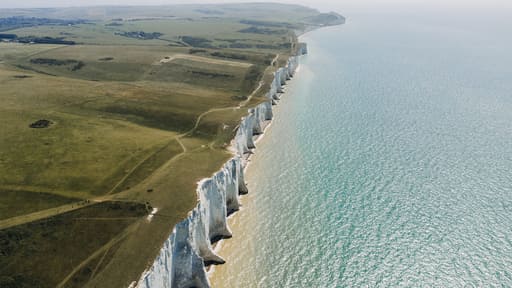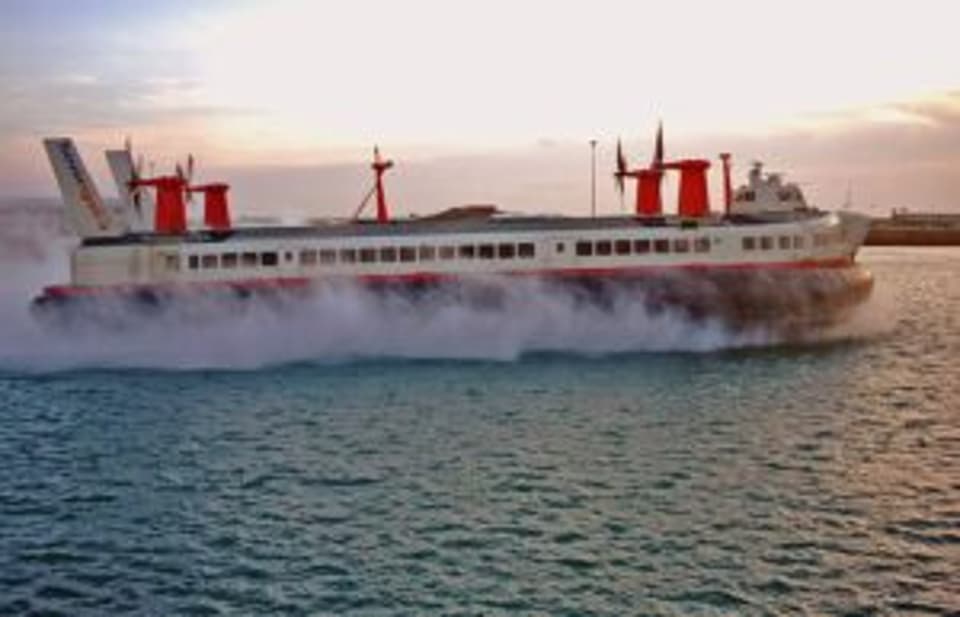A Brief History of Cross-Channel Transport

Urban legend says that in the 1950s, when the English Channel was covered in thick fog, the headline of a French newspaper read: “England cut off.”At the same time, the title “Continent cut off”allegedly appeared in the British press. Regardless of whether the anecdote is true or not, it perfectly reflects not only the spirits of both nations, but also the key importance of the English Channel in communication between the British Isles and the rest of Europe.
Centuries of social and economic development in Europe have resulted in an increasing need to make the exchange of goods between Great Britain and continental Europe as quick and convenient as possible. Let’s dive (pun intended) into the history of the development of ways to cross the English Channel.
Today, traveling across the English Channel between France and the UK, and shipping goods on this route, is as easy as ever before. Well, at least from a technical point of view. Britain’s exit from the European Union meant legal complications. The need to meet a number of requirements, including customs ones, has returned. And more paperwork means a greater risk of making costly mistakes. Therefore, if you are a shipper moving loads from the UK, you may need support with this. As Coyote, we can help you both in the comprehensive organization of transport (including customs services) or we can only handle customs clearance services for you.
But let’s go back to the history of the journeys across the English Channel, i.e. from French Calais to British Dover and back. For the purposes of this article, we will omit what is probably the easiest method of traveling from the UK to France, which is by plane. We will focus on more down-to-earth ways of transporting people and cargo on this route. Down-to-earth literally, but not figuratively, because –as we will try to prove –it is a truly fascinating story.
Transport across the English Channel: on water
If we asked you to think about the first method to travel across the English Channel right now, it would be…probably the one that we will definitely mention here, but not yet. First, we’ll look at the most “classic”way to get from the British Isles to France (or the other way around): ferry.
Archaeological discoveries have provided us with evidence that boats transporting people on this route sailed along the English Channel as early as 3.5 thousand years ago. At the Dover museum, visitors can see the oak hull of a Bronze Age boat that could accommodate twelve passengers. Over the following centuries, traffic between English Dover and French Calais (where the first dock was built by the English in the 14th century, because the city was then under the rule of the Crown) was carried out by cutters: small sailing vessels adapted for coastal navigation.
The 19th century was the age of steam where steam entered the world of shipping with a bang. Also for navigation in the English Channel. In 1821, the “Rob Roy”, a paddle steamer built in Scotland, crossed the Channel. A year later, it was bought by a French company that launched a regular ferry connection on the Strait of Dover. So if the Concorde plane comes to mind when asked about a joint British-French transport venture, “Rob Roy”(later renamed “Henri IV”) beat this supersonic plane by almost 150 years. The development of steam engines also meant the development of railways, which also influenced the popularity of ferry trips across the English Channel. The ports of Dover and Calais were connected to other cities by the rail network, which meant more passengers not only willing, but now also able to travel to the country on the other side of the Channel: first by rail, then by ferry, and then again by train .
The following decades saw the continued development of steam ferries, which meant a reduction in the time needed to sail from Dover to Calais. “Rob Roy” needed 3 hours to do this. In 1854 it was just over 1.5 hours. From 1903, paddle steamers were replaced by turbine ships, which was another step towards speeding up travel through the Strait of Dover.
We jump forward 25 years. This is the era of the car. No wonder that in 1928 a ferry set off on its first voyage from England to France, carrying not only passengers but also cars. There were only 15 automobiles on board, but two years later a ferry called “Forde”was carrying over 160 of them at a time.
After World War II, car ferries became more and more common, and new vessels were also adapted to transport trucks. In 1953, modern ferry terminals for ro-ro/do-do units were opened in Dover and Calais. Today, the Dover terminal services approximately 2.5 million trucks each year.
Transport across the English Channel: over water
Six years after the opening of new ferry terminals in Dover and Calais, a British designer named Christopher Cockerell showed the world his new invention that was supposed to revolutionize transport. We are talking about a hovercraft, i.e. a vehicle moving on an air-cushion, floating a few or a dozen or so millimeters above the ground or water surface. Hovercrafts are a very diverse family of vehicles: from small, one-person units to large machines, even capable of transporting military equipment, as well as passengers and their cars. Just like ferries, only faster and more expensive, but in a more spectacular way.
In 1968, two companies –Seaspeed and Hoverlloyd, which later merged to become Hoverspeed –launched regular hovercraft services between the United Kingdom and France. For this purpose, they used six SR.N4 units (aka Mountbatten class), constructed in the mid-1960s at the Saunders-Roe shipyard (later transformed into the British Hovercraft Corporation).
Powered by four Rolls-Royce Proteus engines, the 56-meter-long and 320-ton behemoths carried 254 passengers and 30 cars (in the later Mk. III version, these values doubled). This made the SR.N4 the largest civilian hovercraft ever built. A record that remains unbroken to this day.
Thanks to a speed of 60 knots (111 km/h), the SR.N4 hovercraft could cross the Strait of Dover in approximately 30 minutes (the fastest course was only 22 minutes). Nevertheless, in 2000, the SR.N4 series hovercraft ceased to be used commercially. Five of them were scrapped and one went to a museum. What “killed” them? Rising fuel prices made them unprofitable compared to ferries. And in 1994, they had one more, very unique competitor.

SRN4 Mountbatten-class hovercraft (Author: Andrew Berridge, CC BY-SA 2.5, Wikipedia)
Transport across the English Channel: underwater
The Concorde already mentioned here is a unique result of technological cooperation between British and French engineers. However, like the SR.N4 hovercraft, it ultimately turned out to be a dead end. Building a technological miracle is one thing, but using it to run a profitable business is another thing (not to mention safety and ecological issues).
In this paragraph, we will describe another child of successful British-French cooperation, which –unlike the supersonic aircraft –is by no means a dead end. It’s also a miracle, but this time of civil engineering. Behold the Eurotunnel!
It was officially opened in 1994 after seven years of construction. It is 50.5 km long and connects Folkestone in the UK and Calais in France. At its deepest point, the tunnel is 75 meters below the seabed and 115 meters below the sealine. The Eurotunnel has the longest underwater section of any tunnel in the world (37.9 km) and is the third longest railway tunnel in the world. The construction of the tunnel was carried out by two consortiums: the British Channel Tunnel Group and the French France-Manche. Today, the tunnel is managed by the European company Getlink based in Paris.
The Eurotunnel is not one tunnel, but three that run parallel to each other. Two are railway tunnels (the first towards “there” and the second “back”), and the third is a service tunnel, intended for emergency services and maintenance. It runs between railway tunnels and is linked to them with connectors (it is intended only for motor vehicles).
The following types of trains run on the Eurotunnel. The passenger-only Eurostar allows you to get from London to Paris (or back) in approximately 2.5 hours or to Brussels in 2 hours. Eurostar is operated by high-speed electric multiple units Eurostar e320 (Siemens Velaro) and Eurostar e300 (Alstom TGV TMST).
A train called LeShuttle is used to transport vehicles. There are separate services for cars, motorcycles and buses and for trucks, operated by the same type of locomotive (ESCL Eurotunnel Class 9). Cars and trucks are loaded at the terminals onto special carriages adapted to transport vehicles. When traveling in the Eurotunnel, drivers and passengers stay in their own cars.
After the tunnel was commissioned in 1994, subsequent types of railway connections were put into operation in phases. First, truck trains started (May), then freight trains (June), then passenger trains (November) and car trains (December).
Today, according to Getlink, LeShuttle transports 1.5 million trucks through the tunnel each year. The number of passengers using Eurotunnel trains is approximately 10 million people a year.
If you ship your loads between Great Britain and mainland Europe and use road transport, then after reading this article you already know how they cross the English Channel. Do you want us to organize the transport of your goods?